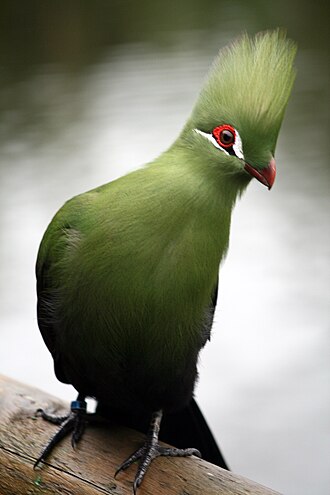Turaco
The turacos make up the bird family Musophagidae (/ˌmjuːzoʊˈfædʒɪdiː/ "banana-eaters"), which includes plantain-eaters and go-away-birds. In southern Africa both turacos and go-away-birds are commonly known as loeries. They are semi-zygodactylous: the fourth (outer) toe can be switched back and forth. The second and third toes, which always point forward, are conjoined in some species. Musophagids often have prominent crests and long tails; the turacos are noted for peculiar and unique pigments giving them their bright green and red feathers.
| Turacos and relatives | |
|---|---|

| |
| Guinea turaco (Tauraco persa) at Birds of Eden aviary, South Africa | |
| Scientific classification | |
| Kingdom: | Animalia |
| Phylum: | Chordata |
| Clade: | Otidimorphae |
| Order: | Musophagiformes Seebohm, 1890 |
| Family: | Musophagidae Lesson, 1828 |
| Genera | |
| Synonyms | |
| |
Traditionally, this group has been allied with the cuckoos in the order Cuculiformes, but the Sibley-Ahlquist taxonomy raises this group to a full order Musophagiformes. They have been proposed to link the hoatzin to the other living birds,[1] but this was later disputed.[2] Recent genetic analyses have strongly supported the order ranking of Musophagiformes.[3][4][5]
Musophagidae is one of very few bird families endemic to Africa.[6] Another order, which is also endemic to Africa are the mousebirds, Colliidae. All turaco species are frugivorous, but they also eat leaves, buds, and flowers. Figs are an important part of their diet. They have rounded wings and long tails and strong legs, making them poor fliers, but good runners.[6]
Turacos are medium-sized arboreal birds endemic to sub-Saharan Africa, where they live in forests, woodland and savanna.
They are gregarious, non-migratory birds which move in family groups of up to 10. Many species are noisy, with the go-away-birds being especially noted for their piercing alarm calls, which alert other fauna to the presence of predators; their common name is onomatopoeia of this. Musophagids build large stick nests in trees, and lay twp or three eggs. The young are born with thick down and open, or nearly-open, eyes.[7]
Turaco Media
Female white-bellied go-away-bird, Crinifer leucogaster
Great blue turacoCorythaeola cristata
References
- ↑ Hughes & Baker (1999)
- ↑ Sorenson et al. (2003)
- ↑ Ericson, P.G.P.; et al. (2006). "Diversification of Neoaves: integration of molecular sequence data and fossils" (PDF). Biology Letters. 2 (4): 543–547. doi:10.1098/rsbl.2006.0523. PMC 1834003. PMID 17148284. Archived from the original (PDF) on 2008-03-07.
- ↑ Hackett, S.J.; et al. (2008). "A Phylogenomic Study of Birds Reveals Their Evolutionary History". Science. 320 (5884): 1763–1768. Bibcode:2008Sci...320.1763H. doi:10.1126/science.1157704. PMID 18583609. S2CID 6472805.
- ↑ Jarvis, E.D.; et al. (2014). "Whole-genome analyses resolve early branches in the tree of life of modern birds". Science. 346 (6215): 1320–1331. Bibcode:2014Sci...346.1320J. doi:10.1126/science.1253451. PMC 4405904. PMID 25504713.
- ↑ 6.0 6.1 Holzman, Barbara A. (2008). Tropical forest biomes. Greenwood Press. ISBN 978-0-313-33840-3. OCLC 470649845.
- ↑ Marchant, S. (1991). Forshaw, Joseph (ed.). Encyclopaedia of Animals: Birds. London: Merehurst Press. p. 125. ISBN 978-1-85391-186-6.
- Ballmann, Peter (1969). "Les Oiseaux miocènes de la Grive-Saint-Alban (Isère) [The Miocene birds of Grive-Saint-Alban, Isère]". Geobios. 2: 157–204. doi:10.1016/S0016-6995(69)80005-7. (French with English abstract)
- Hughes, Janice M.; Baker, Allan J. (1999). "Phylogenetic relationships of the enigmatic hoatzin (Opisthocomus hoazin) resolved using mitochondrial and nuclear gene sequences" (PDF). Molecular Biology and Evolution. 16 (9): 1300–1307. doi:10.1093/oxfordjournals.molbev.a026220. PMID 10486983.
- International Turaco Society (Magazines 1993–2012), also website 2001, www.turacos.org
- Mlíkovský, Jirí (2002): Cenozoic Birds of the World, Part 1: Europe. Ninox Press, Prague. ISBN 80-901105-3-8 PDF fulltext Archived 2011-05-20 at the Wayback Machine
 Newton, Alfred (1911). . In Chisholm, Hugh (ed.). Encyclopædia Britannica. Vol. 27 (Eleventh ed.). Cambridge University Press. p. 102.
Newton, Alfred (1911). . In Chisholm, Hugh (ed.). Encyclopædia Britannica. Vol. 27 (Eleventh ed.). Cambridge University Press. p. 102. {{cite encyclopedia}}: Cite has empty unknown parameter:|coauthors=(help) This is based on a now outdated classification, but does provide a detailed description of the morphology of some species.- Sorenson, Michael D.; Oneal, Elen; García-Moreno, Jaime; Mindell, David P. (2003). "More Taxa, More Characters: The Hoatzin Problem is Still Unresolved". Molecular Biology and Evolution. 20 (9): 1484–1499. doi:10.1093/molbev/msg157. PMID 12777516. S2CID 24173060. Supplementary Material

